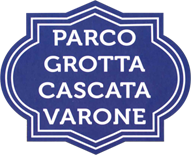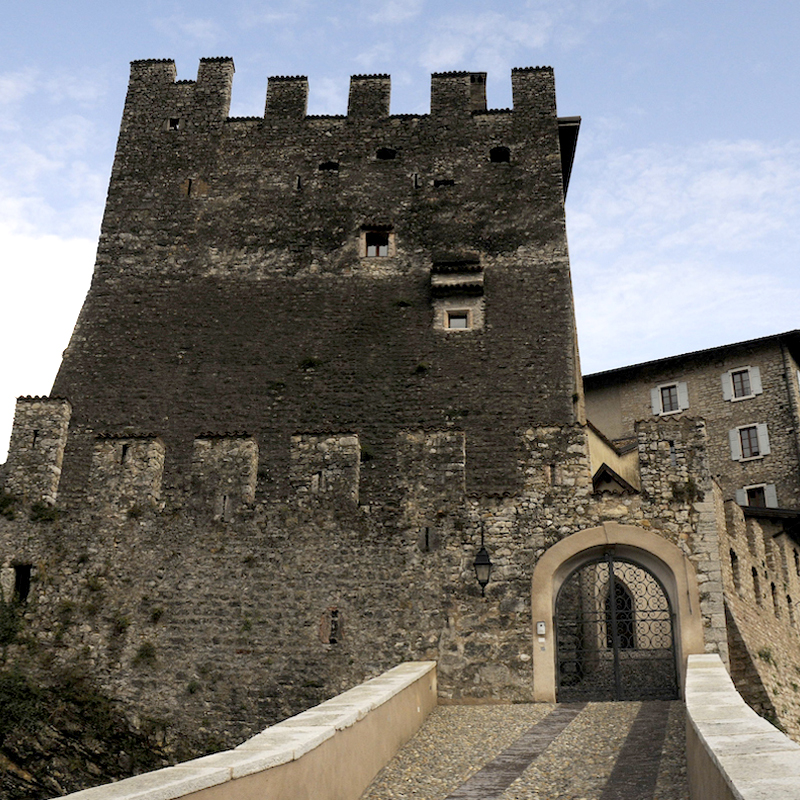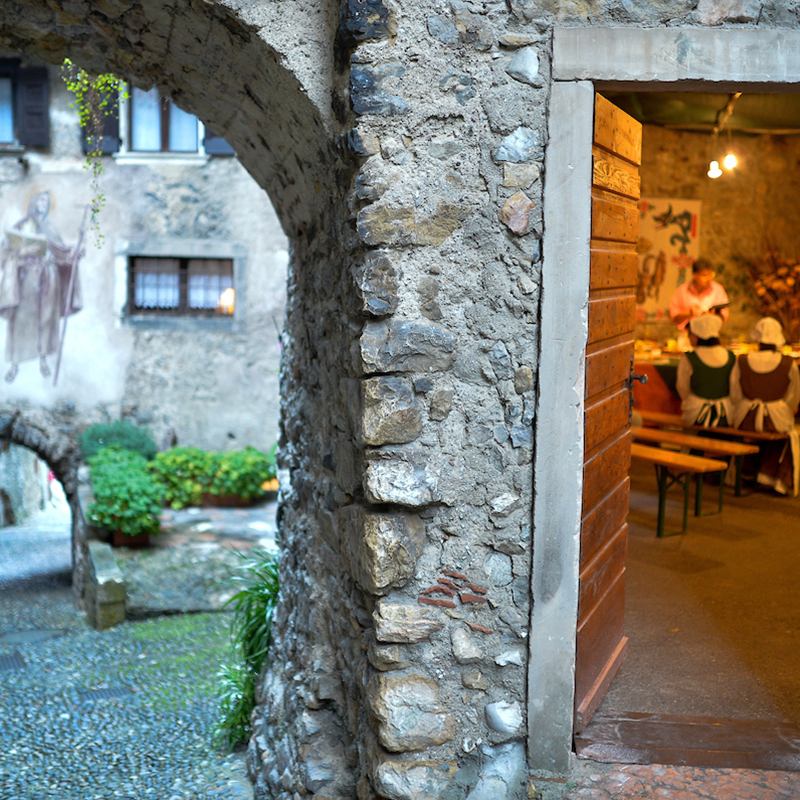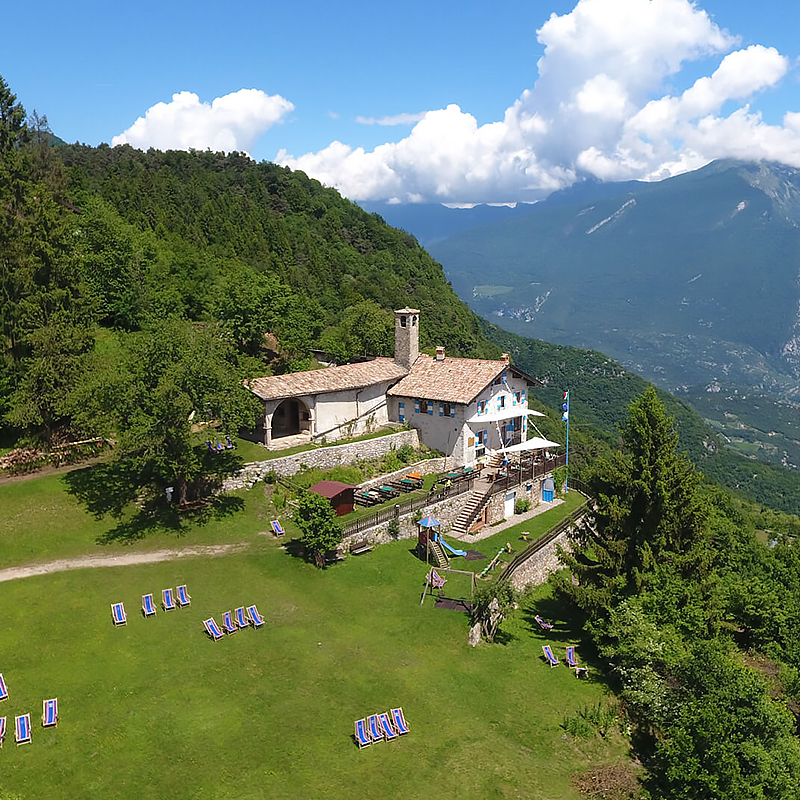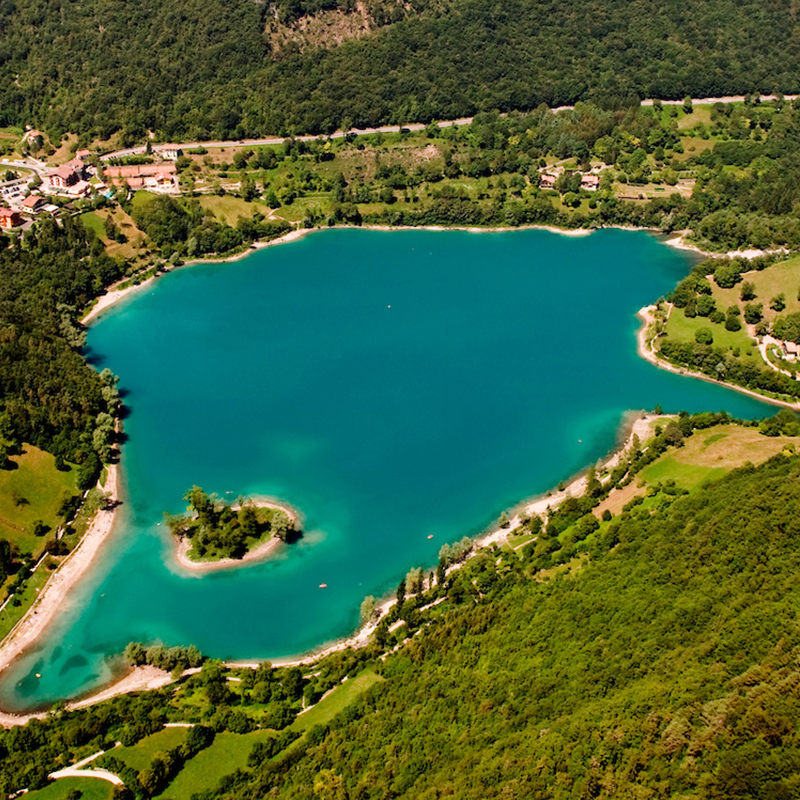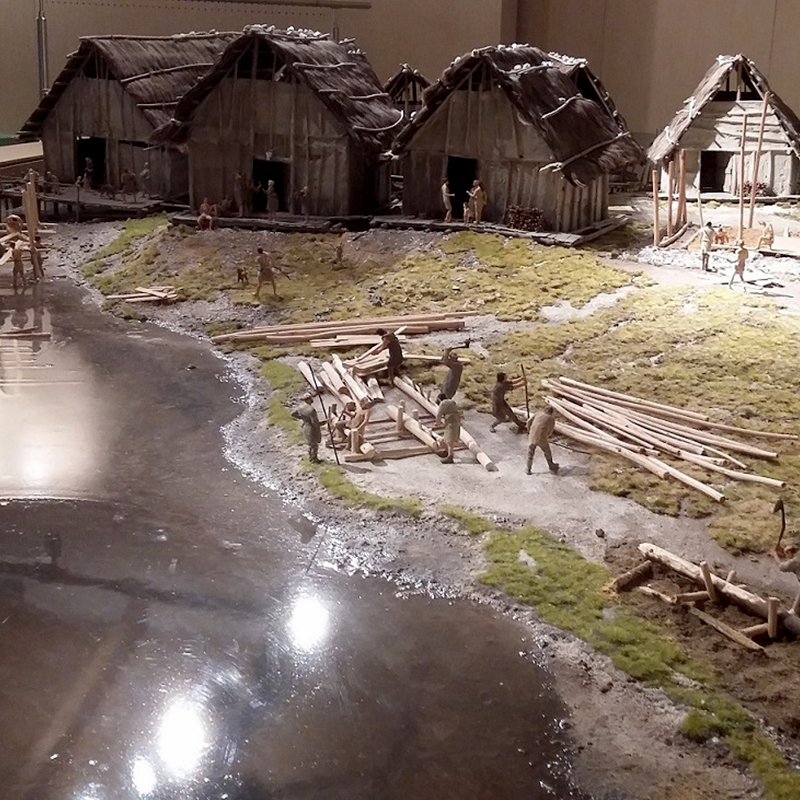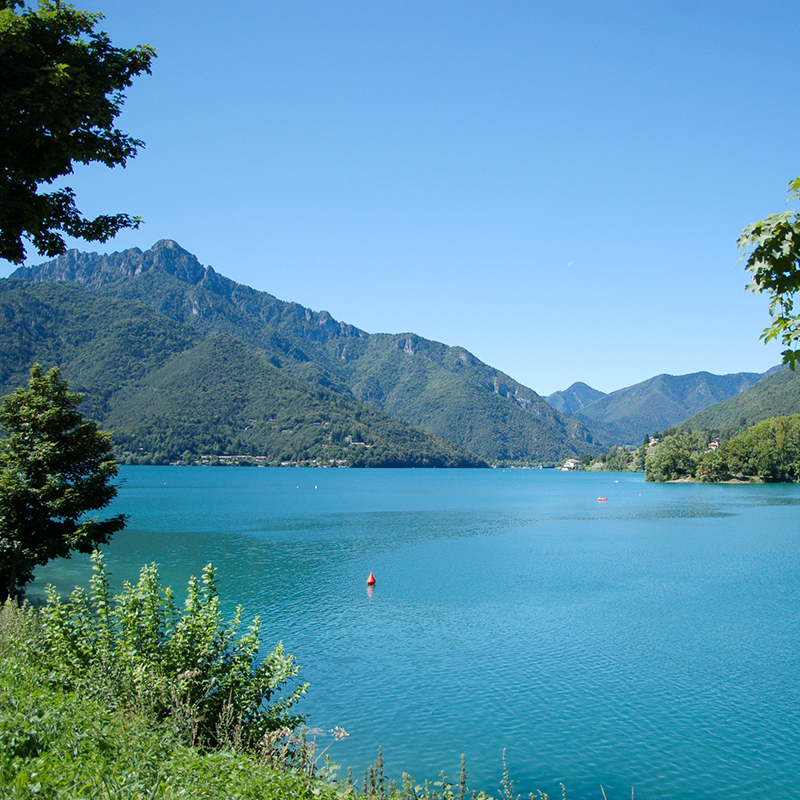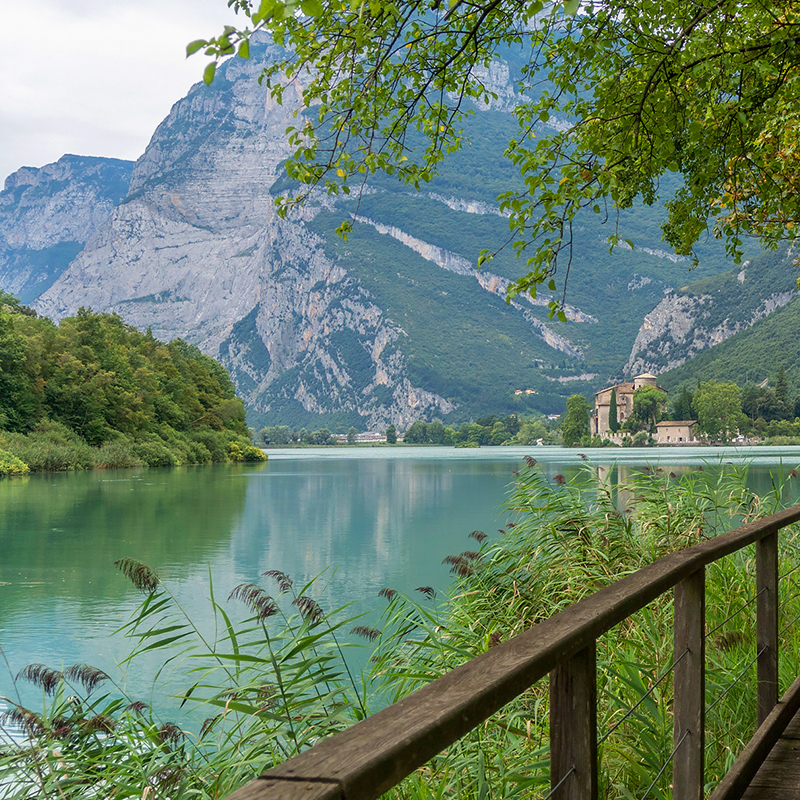Continuation: Around Riva on Lake Garda: things to do
Fascinating and unusual itineraries
Get the most out of your vacation in Riva, Lake Garda: there are plenty of things to do and see!
We would like to suggest you some less well-known excursions which do not yet attract hordes of tourists but which are of particular interest. All of these places are just a few kilometres from the Varone Waterfall: Lake Tenno, Tenno, Canale and Calvola, the San Pietro mountain hut and Lake Ledro.
Each of them has something special and, in some cases, unique.
The village Tenno
(5 km from Varone)
From the car park of the Varone waterfalls, take the main road no.421 to the left which climbs upwards in a winding series of hairpin bends. Past the small village of Gavazzo the view is splendid: down below the top end of Lake Garda is a splash of brilliant light blue surrounded by mountains. Riva del Garda is easy to spot, while further to the left you can see Torbole.
Lake Garda becomes smaller and smaller as the road winds upwards amid the terraces of vines and olive trees. A few metres before the signpost for he village of Cologna (255 metres above sea level), slow down for a moment. On the valley bottom, on the left, there is a red house – the ticket office at the Varone waterfall. In the background, to the left of the red house is the small Ravizze valley and the huge pipe of the hydroelectric power station which carries away part of the waters of the Varone waterfall. From here the waterfall is not visible. However, you now know that it falls into the gorge which you can see to the right of the building. After Cologna, the village famous for its “carne salada”(thin slices of meat with herbs, served with beans and homemade pickled vegetables), the road continues to climb amid the olive trees, the vines and the oleanders, typically Mediterranean trees that in Trentino only grow on the banks of Lake Garda.
Tenno is the last village to feel the influence of the Lake in terms of its mild climate. Once you pass these villages and climb higher, the olive trees and oleanders will all disappear. After a couple of kilometres you come to Tenno (428 metres above sea level), which is an old mediaeval village. The old crenellated castle was largely rebuilt in the late 15th century. It was part of the town's crenellated walls of which today only a part remains.
In Tenno, in addition to the castle, the church of San Lorenzo is also worth seeing. The original church was pre-Romanesque but was rebuilt in the 12th century and then modified again two centuries later; it stands on the edge of a sheer drop and the views from here are wonderful. On the outside of the church notice the apse with fragments of pre Romanesque decoration.
Inside there are various Romanesque frescoes Including a Beheading of St. John the Baptist and a Last Judgement by Giuliano da Verona (1434).
Borgo Medioevale di Canale and Calvòla
(8 kilometres from Varone)
After Tenno the road climbs for a couple of kilometres. At the Ville del Monte fork turn left and follow the signs for Calvola and the San Pletro mountain hut. The road is now a series of narrow hairpin bends and it takes about five minutes by car to get to Canale and another 500 metres to Calvola (pronounced with the stress on the letter "o"). Time seems to have stood still in these two tiny mediaeval villages which have remained unchanged for centuries.
The two villages are among the most picturesque and distinctive in the area.
In Canale there is an old people's home for artists (mainly used in the summer) and the Pinacoteca Europa art gallery. But the real Interest of these two villages are the old stone houses built higgledy-piggledy one against the other; the building technique may be rudimentary but these houses have survived intact for hundreds of years. A stroll along the winding narrow lanes with their rough cobblestones is like stepping back into the past. Not to be missed if possible.
San Pietro mountain hut
(10 kilometres from Varone)
Now get ready for a change. You thought you had come on holiday to Lage Garda? If you have decided to climb right up to the San Pietro mountain hut, then in about ten minutes you will find yourself in a completely different world. Up in the mountains, to be precise, and it feels as if you have come to some refuge in the Tyrol, but there is another surprise awaiting you, as well.
Few people know about it, but the San Pietro mountain hut is truly delightful. It is a small mountain hut standing in the middle of the woods at an altitude of nearly one thousand metres.
To get here carry on along the road which brought you to Canale and Calvola. As you climb the landscape changes colour, becoming more typical of high mountain areas. Continue climbing until you come to a narrow road surrounded by greenery, where you have to park the car and carry on foot. The air is fresh and the vegetation is a triumph of moss, wild raspberries, cyclames and mushrooms. It is almost an adventure to climb up in silence through this wood with its warm colours which is not in the least disquieting but in fact rather relaxing.
You climb for about ten minutes in the shade, with the sun's rays peeping through the dense leafage, until you come to a stone arch: you have arrived at 976 metres above sea level. Beyond this entrance way a green and sunny plain suddenly opens up before you on the slopes of Monte Misone (1803 metres).
The San Pietro mountain hut is a small house with pots of flowers at the windows which welcomes passing wayfarers.
But now for the final surprise: the view to be had from the balcony. One thousand metres below you the deep blue waters of Lake Garda glitter, and looking from right to left you can see Riva del Garda, Torbole and Arco.
Lake Tenno
(9 kilometres from Varone)
If you have come to the San Pietro mountain hut, you only have to go back the way you came, down to the Ville del Monte fork, and follow the signs to Lake Tenno. If on the other hand you wish to get to the lake straight from the Varone waterfall, then turn left onto main road no. 421 and follow the road up to the Ville del Monte fork. After the fork and three kilometres of airpin bends, you come to Lake Tenno which lies in the Tenno-Ballino Valley. In addition to its striking beauty, the lake is worth visiting if only because it gives rise to the Varone waterfall.
Park your car in the space in front of the hotel and follow the path down to the lake. Lake Tenno is 650 metres long and 500 metres wide and lies at an altitude of 570 metres. Its deep blue waters are framed by the green of the dense chestnut and beech woods that extend to the foot of Monte Misone (1,803 metres). In the lake there is a small island covered with dense vegetation the colour of emeralds. This placid mountain lake, with its underground leakage, feed the Magnone stream above the waterfall which in its turn feeds the Varone waterfall itself.
The village Fiavè
(17 km da Varone)
If Canale and Calvola were a step into the past, then Fiavè is a step back into prehistory. After Lake Tenno, follow the main road no. 421 again.
The Tenno-Ballino Valley gets gradually narrower. The sceerey becomes wilder and in a twinkling you find yourself in a valley of dense fir and larch trees which ends at the Ballino Pass (794 metres). After the Ballino Pass, the road begins to go downhill towards the Fiavè plain and the Giudicarie Valley. And over just a few kilometres the scenery undergoes another change. Instead of the stark, severe mountains, a relaxing expanse of green meadows opens up. The village of Fiavè lies in this lovely valley at 700 metres above sea level. Just before the village, at the sports ground, a signpost indicates the pile-dwellings. Here in this pocket of land covering 10,000 square metres, there was once a prehistoric settlement which is now of considerable archaeological value.
Today what remains of this prehistoric settlement is a small marsh with the piles that once supported the dwelling sticking up out of the water. The settlement dates back to the middle of the Neolithic period and was inhabited throughout the Bronze Age right up until the beginning of the Iron Age. A few tools, terracotta vessels and wooden articles have been recovered from the marsh dating back to this period. It is strange to think of prehistoric people going about their business in this part of Trentino a full two thousand years before Jesus Christ was born.
The area is part of the Outer Giudicarie Valley through which the River Sarca flows. The romans also once passed through here and in around the 1,000 the Prince Bishop of Trento established their rule in the area. The name “Giudicarie” comes from the word “giudice” or “judge”. The judge was the Church’s man placed here for military and political reasons to govern the area.
Lake Ledro
(18 kilometres from Varone)
This is a lovely excursion for the splendid views it offers. From the Varone waterfall go back towards Riva and just before reaching the town, you will find indications to Valle di Ledro. A tunnel will take you directly to the valley. After the villages of Biacesa and Prè, the scenery changes suddenly: it is green and mountainous and full of pine trees. When you get to Molina you will notice that the temperature has dropped.
Lake Ledro is a typical mountain lake which is morainal in origin (moraine is debris deposited by glaciers which forms a hollow and then, after the retreat of the glacier, fills with water to form a lake). It lies in the middle of the Ledro Valley at an altitude of 655 metres above sea level. It is long and irregular in shape (2.8 kilometres long and reaching a maximum width of 1.5 kilometres), and its clear blue waters contrast with the surrounding deep green of the meadows and mountains.
On the shore a life size pile dwelling has been reconstructed while in the lake itself wooden plies stick up out of the water. This is all that remains of a large settlement of pile dwellings which existed here some 4.000 years ago (it was inhabited from the second millennium BC to about 1,300 BC) and covered about 4.500 square metres.
This prehistoric settlement at Ledro was discovered by accident in 1929 when the level of the lake fell as a result of work carried out in an attempt to exploit the water for hydroelectric power. At least 10.000 piles were found sticking out of the water and they were left where they were and fenced off (the public is not allowed into this area). In addition to the surviving piles of the pile-dwellings, the remains of a canoe, about 5 metres long, were also found, evidence that the inhabitants were probably proficient sailors as well.
Lago di Toblino
(20 km da Varone)
Goingo to Lake Toblino is like walking into a fairy tale. The lake is exceptionally beautiful and every year attracts greater number of tourists.
Leave the car park at the waterfall and go down for about 200 metres until you come to the sign for Arco. This takes you onto a little used road which is an alternative way to get to Arco. Go through Arco, a small town that has been called the “Siena of Trentino” for its picturesque old town centre, and carry on towards Trento on the main 45 bis road. The bridge that you now come to spans the River Sarca which is the largest river in the area. Riva del Garda is in the Lower Sarca Valley and the River Sarca itself starts up in the snowy peaks of the Brenta massif. On this journey you will find that the Sarca constantly appears on one or the other side of the road.
After Arco the valley opens out into a gentle green plain filled with fruit orchards. The fruit grown here is, of course, the famous apples of Trentino and the Laghi Valley plums.
At this point the countryside presents an interesting contrast: on the right of the road lies the green and tranquil valley while on the left the road is close to the sheer and virtually vertical rock faces of the mountains.
After the village of Dro the valley begins to close in. Very soon the scenery takes on a surreal aspect. First of all there are massive stone boulders everywhere. This enormous stone barrier, which is all that can be seen at this point on the valley floor, is the work of glacial erosion. The glaciers broke up the rocks and then left the debris behind them ad they receded. After two or three kilometres you emerge from this moonscape and the valley returns to normal.
Near Pietramurata the sides of the mountains become steeper. At their feet are enormous piles of stones. Many films have been shot in this area, especially spaghetti-westerns, because of the similarity between the landscape here and the canyons of the American Far West.
At the Sarche for take the road towards Trento. The other direction goes to Madonna di Campiglio, about an hour’s drive away. A couple of kilometres past Sarche, a gentle attractive landscape opens up where Nature finally seems to be at peace with herself. Lake Toblino is a small lake and could not be more different to the mountain lakes of Tenno and Ledro.
Rather it has a touch of magic and a fairy-like quality about it, thanks also to the romantic Toblino Castle which stands on a tongue of land just out into the lake and which is reflected in the lake’s waters. The scene brings to mind the dreamy princesses and princes on white charges from certain North European fairy tales. The lake is inhabited by families of coots and is filled with beds of feathery reeds. If you wish to take a break here, there is a bar and restaurant at Toblino Castle.
If you continue along the main 45 bis road, you come to Trento along an alternative route that avoids the motorway.
